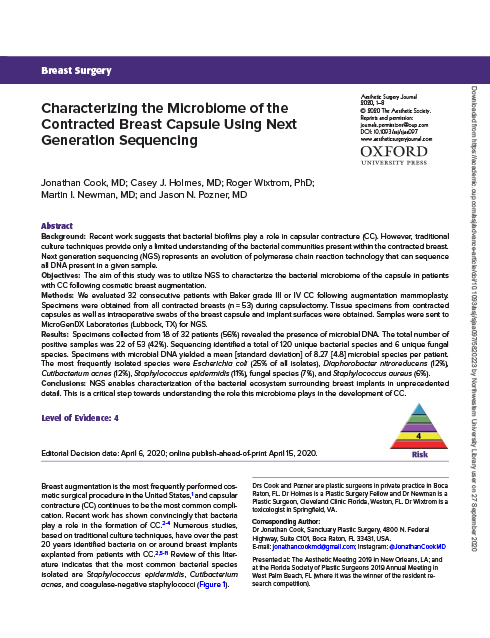Published Studies

Analysis of the chronic wound microbiota of 2,963 patients by 16S rDNA pyrosequencing.
Wound Repair Regen. 2016 Jan-Feb;24(1):163-174.
Research: The study utilized 16S rDNA pyrosequencing to analyze the composition of the bacterial communities present in samples obtained from patients with chronic diabetic foot ulcers (N = 910), venous leg ulcers (N = 916), decubitus ulcers (N = 767), and nonhealing surgical wounds (N = 370). All wound types examined in the study exhibited similar levels of microbial diversity and abundance at a genus level. Neither patient demographics nor wound type influenced the bacterial composition of the chronic wound microbiome. Staphylococcus and Pseudomonas were the two most frequent bacterial genera identified, however significant variability was observed in their abundance. Staphylococcus was the most frequent bacterial genus present in the polymicrobial communities of the chronic wound samples tested; of these, 40% were methicillin‐resistant. Pseudomonas spp. were present in 25% of all wound samples analyzed. Strict anaerobes comprised four of the top 10 genera detected in the chronic wound samples. Read Research

Molecular diagnostics and personalized medicine in wound care: assessment of outcomes.
J Wound Care. 2011;20(5):232-239.
Retrospective Study: This level A, retrospective cohort study compared healing outcomes in three large cohorts (400-500 patients each) of wound patients managed universally for bioburden: standard of care group, who were prescribed systemic antibiotics on the basis of empiric and traditional culture-based methodologies; treatment group 1, who were prescribed an improved selection of systemic antibiotics based on the results of molecular diagnostics; treatment group 2 who received personalized topical therapeutics (including antibiotics) based on the results of molecular diagnostics. In comparison to the standard of care group, healing rates improved from 48.5% to 62.4% in treatment group 1 and to 90.4% for treatment group 2. The time to complete closure decreased by 26% in treatment group 1 (p<0.001) and 45.9% in treatment group 2 (p<0.001) compared with the standard of care group. Patients in treatment group 2 had >200% better odds of healing at any given time point compared with the other cohorts. Read Study

The Microbiome of Diabetic Foot Osteomyelitis
Eur J Clin Microbiol Infect Dis (2016) 35:293–298
Research Article:The purpose of this investigation was to evaluate the diversity of bacteria in diabetic foot osteomyelitis using a 16S rRNA sequencing approach and to compare the results with conventional culture techniques. In this prospective observational study, we obtained 34 bone samples from patients admitted to our hospital with a moderate–severe diabetic foot infection.We analysed the distribution of the 16S rRNA gene sequences in the bone samples, using an Illumina MiSeq Personal Sequencer. We compared the genera that were detected with the cultured pathogens in the bone samples with conventional techniques. Read Article

Characterizing the Microbiome of the Contracted Breast Capsule Using Next Generation Sequencing
Aesthetic Surgery Journal 2020 Apr 15;sjaa097
Abstract: Recent work suggests that bacterial biofilms play a role in capsular contracture (CC). However, traditional culture techniques provide only a limited understanding of the bacterial communities present within the contracted breast. Next generation sequencing (NGS) represents an evolution of polymerase chain reaction technology that can sequence all DNA present in a given sample. Read Abstract

Comparison of culture and molecular identification of bacteria in chronic wounds.
Int J Mol Sci. 2012;13(3):2535-2550.
Comparative Retrospective Study: A total of 168 chronic wounds were studied, using both aerobic bacterial cultures and culture-free DNA analysis. Seventeen (17) different bacterial taxa were identified with culture, and 338 different bacterial taxa were identified with molecular testing. The majority of bacteria identified with the molecular testing were not identified with culture testing; many of these bacteria were obligate anaerobes. In the majority of the samples, culture underreported the diversity of the wound microbiota and failed to detect the most abundant bacteria in the wound. This study demonstrates the increased sensitivity that molecular microbial identification can have over culture methodologies. Read Study

Clinical identification of bacteria in human chronic wound infections: culturing vs. 16S ribosomal DNA sequencing.
BMC Infect Dis. 2012;12:321-329
Comparative Study: Parallel samples from 51 chronic wounds were studied using aerobic culturing and 16S DNA sequencing for the identification of bacteria. Compared to 16S DNA sequencing, aerobic culture detected only half of the bacteria determined to comprise a dominant portion of the microbiota. At the genus level, molecular testing identified 85% (78/92) of the bacteria identified by culture. Conversely, culturing detected 15.7% (78/497) of the aerotolerant bacteria and detected 54.9% of the collective aerotolerant relative abundance of the samples. Read Study
